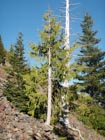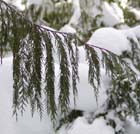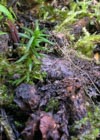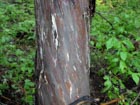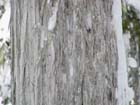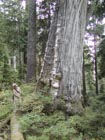Conservation Status

Callitropsis nootkatensis
(D. Don) Oerst. 1864
Common names
Nootka cypress, Alaska yellow-cedar, Alaska cedar, yellow cypress (Peattie 1950, Pojar & Mackinnon 1994). I am partial to the name Nootka cypress because it was its original vernacular English name, because its distribution includes all coastal states and provinces from Alaska to California, and because it is neither yellow nor a cedar.
Taxonomic notes
The sole species in Callitropsis Oerst. (1864). This species has one of the most convoluted history of names to be found among the conifers, and even now you will commonly see it placed in any of four genera. For a full list of synonyms see POWO (accessed 2023.12.16). Nonetheless, it has always been regarded as a distinct and distinctive species. See Cupressus for further discussion.
No natural infraspecific variants have been recognized, but Callitropsis nootkatensis in cultivation has spontaneously hybridized with three other cypresses, Hesperocyparis glabra, H. lusitanica, and H. macrocarpa.
- The hybrid with H. glabra is x Hesperotropsis notabilis; see POWO (accessed 2023.12.16).
- The hybrid with H. lusitanica is x Hesperotropsis ovensii; see POWO (accessed 2023.12.16).
- The hybrid with H. macrocarpa is x Hesperotropsis leylandii; see POWO (accessed 2023.12.16).
The evolutionary origins of Callitropsis were traced by Terry et al. (2016) in a molecular clock analysis. They found that the New World cypress clade diverged from the Old World Cupressus and colonized from Asia at about the beginning of the Cenozoic, with migration from northwest to southeast as climates became increasingly cool and arid through Cenozoic time. The division between Callitropsis and Hesperocyparis occurred about 42 million years ago. The species of Hesperocyparis continued their southern movement, while Callitropsis today is the most northern species among the Cupressaceae, excepting two Juniperus species. The age of Callitropsis nootkatensis is not known; various molecular clock studies in the Cupressaceae have found species ages ranging from less than a million years up to about 40 million years. The most likely scenario, though, is that C. nootkatensis is the sole survivor of a formerly more extensive suite of Callitropsis species.
Description
Trees to 40 m or dwarfed at high elevations; trunk to 200 cm dbh. Bark grayish brown, 1-2 cm thick, irregularly fissured. Branchlet sprays pinnate. Leaves of branchlets mostly 1.5-2.5 mm, stout, occasionally glandular on keel, apex rounded to acute or acuminate, bases of facial leaves often overlapped by apices of subtending facial leaves; glands usually absent (circular when present). Pollen cones 2-5 mm, grayish brown; pollen sacs yellow. Seed cones maturing and opening the second year, rarely in some southern lowland populations late in the first year, in (10-)16-18 months (El-Kassaby et al. 1991, Owens & Molder 1975), 8-12 mm broad, glaucous, dark reddish brown, becoming resinous; scales 4-6, valvate with an open apex; a small central columella between the apical pair of scales. Seeds 2-4 per scale, 2-5 mm, wing equal to or broader than body (Michener 1993, M.P. Frankis e-mail 1999.02.05). See García Esteban et al. (2004) for a detailed characterization of the wood anatomy.
In habitat, this tree is most likely to be confused with Thuja plicata. Mature trees are easily distinguished by their bark (gray in T. plicata, nearly white in C. nootkatensis) and the seed cones are very distinct (bilaterally symmetrical in T. plicata, nearly globose in C. nootkatensis). The foliage is bifacially flattened and the foliar units (sprays) have many alternate lateral shoots in T. plicata; in C. nootkatensis the branchlets are 4-angled and the foliar units have fewer lateral shoots and, generally, are less symmetrical in form.
Distribution and Ecology
USA, Canada: Pacific Coast area from S and SE Alaska through British Columbia, Washington and Oregon to extreme NW California; locally found farther inland; at 600-2100 m in the S, to sea level in the N (Peattie 1950). Disjunct inland populations occur in BC and OR (Michener 1993); here are my field notes from a visit to the Oregon grove in the Aldrich Mountains, in June 2013, and the BC populations are described by Perry (1954) and Hennon et al. (2016). Usually found on mesic to hygric sites including avalanche chutes, snowy timberlines, and bog-forest transition areas (Pojar & Mackinnon 1994). Although it usually occurs in mixed conifer forests (most often with Tsuga mertensiana), it occasionally forms pure stands (Little 1980).
Data from USGS (1999).
I have long wondered why this species has its characteristic range limitations. A backcountry ski trip in 2002 suggested part of the answer. In the southern Cascade Mountains of Washington, Nootka cypress grows in the company of subalpine conifers such as Abies amabilis and Tsuga mertensiana. The area experiences very heavy winter snowfall, sometimes in excess of 10 meters. Most of the trees develop very heavy mantles of snow, and breakage due to snow loading is a common cause of death among saplings. C. nootkatensis, however, sheds the snow because its foliage hangs almost straight down and both foliage and bark are smooth and not easily wetted. The photographs at right illustrate this, with a C. nootkatensis sapling showing bare and dark against the snow-clad firs around it. This bare tree, however, is therefore put greatly at risk of the chief enemy of trees living in the high mountains, which is exposure to winter's icy blast. Snow crystals blown above the snow can erode the cuticle from exposed foliage, readily drying and killing it, and a sheltering cloak of snow offers critical protection from such desiccation. Thus we find the C. nootkatensis distribution limited to areas where winters are mild and the risk of blasting by blown ice crystals is low, i.e., in the maritime mountains of the wet Pacific Northwest.
See also Thompson et al. (1999). Hardy to Zone 5 (cold hardiness limit between -28.8°C and -23.3°C) (Bannister and Neuner 2001).
Remarkable Specimens
The largest known tree is diameter 416 cm, height 61.0 m, located in Kelsey Bay, Vancouver Island, British Columbia (R. Van Pelt [pers. comm. 1998.03.18], who measured it; though this is an old measurement, it was laser-based, and I don't have any evidence that it has been remeasured). In the United States, the largest known is diameter 364 cm, height 37.8 m, located in Olympic National Park, Washington (American Forests 2000); I visited this tree in 2022 and although it is still alive, it is mostly dead with only a strip of live bark connected to a small volume of live crown.
The oldest tree recorded is a sample having 1834 rings, from the Caren Range, Sechelt Peninsula, British Columbia, collected by M. L. Parker (Robert Van Pelt e-mail 1998.03.18). There is also a record of 1636 years for a specimen from Vancouver Island collected by L. Jozsa (Brown 1996). Both ages represent ring counts from stumps in clearcuts. There is also a record of two crossdated trees from northern Vancouver Island that were 1371 and 1452 years old at the time they were logged (Parish and Antos 2004). The oldest record for a tree that I am reasonably sure is still alive, is 949 years, documented in a tree-ring chronology covering the period 1067-2015 (crossdated after 1088), collected at a site near Baker Lake, Washington by Andy Bunn, C. R. Trinies, and C. S. Robertson (doi.org/10.25921/j01a-m794).
Ethnobotany
The tough, straight-grained wood was used by nearly all Northwest Coast peoples for bows, canoe paddles, ceremonial masks, chests, dishes, digging sticks, adze handles, and fish net hoops. The bows were a popular trade item, sometimes traded well beyond the species' range. Branch tips and green cones were used medicinally. In folklore, the tree was believed to have once had human form (Pojar & Mackinnon 1994).
Modern society uses the wood for furniture, finish carpentry, and boats (Little 1980).
In research, this species has been studied to date periods of bark harvesting by native peoples and to determine stand ages. Generally it shows has poor circuit uniformity and low sensitivity, so it is of limited use in dendroclimatic studies, but there are exceptions (Laroque and Smith 1999, Trinie et al. 2022).
The hybrid of this species with Hesperocyparis macrocarpa (Leyland cypress), is of major horticultural importance, particularly in Britain where it arose about 100 years ago. It accounts for 99.5% of the suburban hedge plant market there, despite being far too vigorous for this purpose, growing at 0.5-0.8 m per year to 35 m or more if not trimmed frequently. Two other hybrids, with H. glabra and H. lusitanica, are also known in cultivation, but are not widely planted (M.P. Frankis e-mail 1999.02.05). The hybridization works with both male and female C. nootkatensis, and the F1 hybrids are interfertile as well (Jackson and Dallimore 1926, in Little et al. 2004).
Observations
Common in high montane and subalpine forests of the Cascade Range, Washington and Oregon. Some pure old-growth stands are found in Mt. Rainier National Park, and it is codominant with Tsuga mertensiana near timberline at Jefferson Park, Mt. Jefferson Wilderness, Oregon.
Remarks
The epithet refers to the type locality, in Nootka Sound. The crushed foliage and freshly cut wood has a rather rank odor.
Citations
American Forests 2000. The National Register of Big Trees 2000. Washington, DC: American Forests.
El-Kassaby, Y. A. et al. 1991. Reproductive-cycle plasticity in yellow-cedar. Canadian Journal of Forest Research 21: 1360-1364.
Hennon, P. E., McKenzie, C. M., D’Amore, D., Wittwer, D. T., Mulvey, R. L., Lamb, M. S., Biles, F. E., and Cronn, R. C. 2016. A climate adaptation strategy for conservation and management of yellowcedar in Alaska. U.S. Department of Agriculture, Forest Service, Pacific Northwest Research Station, Portland, OR. doi:10.2737/PNW-GTR-917.
Jackson, A. B. and W. Dallimore. 1926. A new hybrid conifer. Kew Bulletin of Miscellaneous Information 3: 113-115.
Lambert, A. B. 1824. A description of the genus Pinus, V. 2, p. 18; available at http://cupressus.net/CUnootkatensisLambert.html, accessed 2019.02.03.
Laroque, C., and D. J. Smith. 1999. Tree-ring analysis of yellow-cedar (Chamaecyparis nootkatensis) on Vancouver Island, British Columbia. Canadian Journal of Forest Research 29: 115-123.
Ørsted, A. S. 1864. Frilands-Trøvøxten i Danmark, vol. 1, pp. 17-18. Copenhagen. This is an incredibly obscure publication; the relevant text has been quoted by Maerki and Frankis (2012).
Parish, Roberta, and Joseph A. Antos. 2004. Structure and dynamics of an ancient montane forest in coastal British Columbia. Oecologia 141(4):562-576.
Perry, R. S. 1954. Yellow cedar: its characteristics, properties, and uses. For. Br. Bull. 114. Ottawa, ON: Canadian Department of Northern Affairs and Natural Resources. 19 p.
Terry, Randall G., Matthew I. Pyne, Jim A. Bartel, and Robert P. Adams. 2016. A molecular biogeography of the New World cypresses (Callitropsis, Hesperocyparis; Cupressaceae). Plant Systematics and Evolution 302:921–942. https://doi.org/10.1007/s00606-016-1308-4.
Trinies, C. A., Bunn, A. G., Robertson, C. S., and Anchukaitis, K. J. 2022. Dendroclimatology of yellow-cedar (Callitropsis nootkatensis) and temperature variability on the western slopes of the North Cascades in Washington State, USA, from 1333 to 2015 CE. Tree-Ring Research 78(2):113–128.
This page edited with the help of M. P. Frankis, 1999.02.
See also
Debreczy, Z., K. Musial, R.A. Price, and I. Racz. 2009. Relationships and nomenclatural status of the Nootka cypress (Callitropsis nootkatensis, Cupressaceae). Phytologia 91(1):140-159.
Elwes and Henry 1906-1913 at the Biodiversity Heritage Library. This series of volumes, privately printed, provides some of the most engaging descriptions of conifers ever published. Although they only treat species cultivated in the U.K. and Ireland, and the taxonomy is a bit dated, still these accounts are thorough, treating such topics as species description, range, varieties, exceptionally old or tall specimens, remarkable trees, and cultivation. Despite being over a century old, they are generally accurate, and are illustrated with some remarkable photographs and lithographs.
Farjon (2005) provides a detailed account with illustrations.
Frankis, M. P. 1993. Nootka Cypress: Chamaecyparis or Cupressus? Conif. Soc. Austral. Newsletter 12: 9-10.
Grescoe, A. and B. Herger. 1997. Giants: the colossal trees of Pacific North America. Boulder, CO: Roberts Rinehart.
Harrington, C. A. (tech. coord.). 2010. A tale of two cedars: International symposium on western redcedar and yellow-cedar.. U.S. Forest Service General Technical Report PNW-GTR-828.
Contains significant papers on ethnobotany, ecology and distribution, soil nutrient dynamics, dendrochronology, responses to fungal attack, mortality, climate change, wood extracts, growth, and responses to varied silvicultural treatments.
Hennon, P. E. and A. S. Harris. 1997. Annotated bibliography of Chamaecyparis nootkatensis. http://www.fs.fed.us/pnw/pubs/pnw_gtr413.pdf, accessed 2015.05.13, now defunct.
Welch, H. J. 1991. The Conifer Manual vol. 1.

